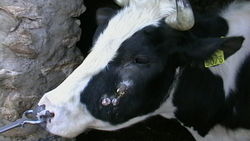Difference between revisions of "Actinomyces bovis"
m (Text replace - "Category:To_Do_-_AimeeHicks" to "") |
|||
| Line 17: | Line 17: | ||
It is found naturally in the oral cavity of cattle and prefers anaerobic conditions but is not a strict anaerobe. Entry of the organism into tissues is following trauma to the mucosa from rough feed or tooth eruption. It causes [[Granulomatous Inflammation|granulomatous inflammation]] of soft tissues and bone, causing [[Mandibular Osteomyelitis|lumpy jaw]]. | It is found naturally in the oral cavity of cattle and prefers anaerobic conditions but is not a strict anaerobe. Entry of the organism into tissues is following trauma to the mucosa from rough feed or tooth eruption. It causes [[Granulomatous Inflammation|granulomatous inflammation]] of soft tissues and bone, causing [[Mandibular Osteomyelitis|lumpy jaw]]. | ||
| − | It usually invades the mandible to cause [[ | + | It usually invades the mandible to cause [[Osteomyelitis|osteomyelitis]] and may extend to surrounding muscles. |
==Pathology== | ==Pathology== | ||
Revision as of 12:19, 3 March 2011
| This article has been peer reviewed but is awaiting expert review. If you would like to help with this, please see more information about expert reviewing. |
| Actinomyces bovis | |
|---|---|
| Phylum | Actinobacteria |
| Class | Actinobacteria |
| Order | Actinomycetales |
| Family | Actinomycetaceae |
| Genus | Actinomyces |
| Species | A.bovis |
Overview
Actinomyces bovis is a species of the Actinomyces genus.
It is found naturally in the oral cavity of cattle and prefers anaerobic conditions but is not a strict anaerobe. Entry of the organism into tissues is following trauma to the mucosa from rough feed or tooth eruption. It causes granulomatous inflammation of soft tissues and bone, causing lumpy jaw. It usually invades the mandible to cause osteomyelitis and may extend to surrounding muscles.
Pathology
The lesion begins as a painless swelling of the affected bone, the swelling becomes more painful and enlarges over a number of weeks, gaining fistulous tracts which discharge pus. The organisms are found in yellow sulphur granules and have club colony formation. Colonies adhere to agar media and are non-haemolytic.
Treatment
Surgical treatment is possible when the lesions are small and prolonged parenteral penicillin treatment may be beneficial early in the disease.
Literature Search
Use these links to find recent scientific publications via CAB Abstracts (log in required unless accessing from a subscribing organisation).
Actinomyces bovis publications

